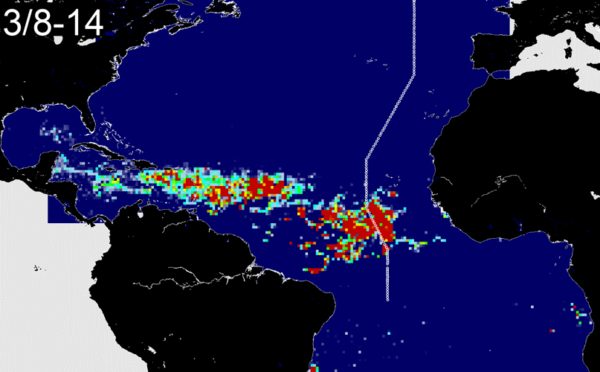Under normal conditions, the floating macroalgae Sargassum spp. provide habitat for hundreds of types of organisms. However, the Great Atlantic Sargassum Belt (GASB) that emerged in 2011 has since then caused unprecedented inundations of this brown seaweed on Caribbean coastlines, with harmful effects on ecosystems while posing challenges to regional economies and tourism, and concerns for respiratory and other human health issues.
Sargassum coverage based on satellite data. The white circles indicate sampling locations on GO-SHIP line A16. (Image courtesy of C. Hu and B. Barnes)
Researchers looking into the question of what is the nutrient supply for the GASB say that they have now clearly identified that the nutrient content of Sargassum tissue could help determine the enrichment sources and potentially improve predictions and Sargassum management efforts.
“We show clearly for the first time that Sargassum in the GASB is enhanced in both nitrogen and phosphorus, indicative of a healthy and thriving population,” according to the journal article “Nutrient and arsenic biogeochemistry of Sargassum in the western Atlantic,” published in Nature Communications.
The paper notes that a variety of nutrient sources for the GASB blooms have been suggested, including upwelling, vertical mixing, discharge from the Amazon and Congo rivers, and atmospheric deposition. Though, the paper states that the causes of the GASB and the mechanisms controlling its variability remain unknown.
The paper also indicates that the nutritional status of Sargassum in the GASB is enriched, with higher nitrogen and phosphorus content than are populations of Sargassum that reside in its Sargasso Sea habitat.
The finding that nitrogen and phosphorus are higher in the GASB than in the Sargasso Sea “is a smoking gun that the GASB inundations are nutrient-driven,” said McGillicuddy. “A consequence of this finding is that it presents us potentially with the opportunity to use those nitrogen and phosphorus markers in Sargassum tissue to fingerprint the ultimate sources of these nutrients that are sustaining these seaweed blooms.”
In addition, the paper notes that the presence of arsenic in Sargassum tissue – which reflects phosphorus limitation – significantly constrains the utilization of the seaweed biomass that washes ashore.
To read more click here. and for the full Journal article click here
